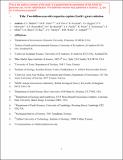Files in this item
Two-billion-year-old evaporites capture Earth's great oxidation
Item metadata
| dc.contributor.author | Blättler, Clara | |
| dc.contributor.author | Claire, Mark | |
| dc.contributor.author | Prave, Anthony Robert | |
| dc.contributor.author | Kirsimäe, K. | |
| dc.contributor.author | Higgins, J. A. | |
| dc.contributor.author | Medvedev, P. V. | |
| dc.contributor.author | Romashkin, A. E. | |
| dc.contributor.author | Rychanchik, D. V. | |
| dc.contributor.author | Zerkle, Aubrey Lea | |
| dc.contributor.author | Paiste, K. | |
| dc.contributor.author | Kreitsmann, T. | |
| dc.contributor.author | Millar, I. L. | |
| dc.contributor.author | Hayles, J. A. | |
| dc.contributor.author | Bao, H. | |
| dc.contributor.author | Turchyn, A. V. | |
| dc.contributor.author | Warke, Matthew Robert | |
| dc.contributor.author | Lepland, A. | |
| dc.date.accessioned | 2018-03-23T11:30:05Z | |
| dc.date.available | 2018-03-23T11:30:05Z | |
| dc.date.issued | 2018-04-20 | |
| dc.identifier | 252070717 | |
| dc.identifier | e8a141cf-d257-4529-8037-69c4a99852c2 | |
| dc.identifier | 29567810 | |
| dc.identifier | 85044455051 | |
| dc.identifier | 000430396600045 | |
| dc.identifier.citation | Blättler , C , Claire , M , Prave , A R , Kirsimäe , K , Higgins , J A , Medvedev , P V , Romashkin , A E , Rychanchik , D V , Zerkle , A L , Paiste , K , Kreitsmann , T , Millar , I L , Hayles , J A , Bao , H , Turchyn , A V , Warke , M R & Lepland , A 2018 , ' Two-billion-year-old evaporites capture Earth's great oxidation ' , Science , vol. 360 , no. 6386 , pp. 320-323 . https://doi.org/10.1126/science.aar2687 | en |
| dc.identifier.issn | 0036-8075 | |
| dc.identifier.other | ORCID: /0000-0001-9518-089X/work/42954175 | |
| dc.identifier.other | ORCID: /0000-0001-9830-0383/work/42954190 | |
| dc.identifier.other | ORCID: /0000-0003-2324-1619/work/60427926 | |
| dc.identifier.other | ORCID: /0000-0002-4614-3774/work/64033675 | |
| dc.identifier.uri | https://hdl.handle.net/10023/13006 | |
| dc.description | Funding sources: Simons Foundation (SCOL 339006 to C.L.B.), European Research Council (ERC Horizon 2020 grant 678812 to M.C.), Research Council of Norway (RCN Centres of Excellence funding scheme project 223259 to K.P. and A.L.), Estonian Science Agency (PUT696 to K.K., A.L., K.P., T.K.). | en |
| dc.description.abstract | Major changes in atmospheric and ocean chemistry occurred in the Paleoproterozoic Era (2.5–1.6 billion years ago). Increasing oxidation dramatically changed Earth’s surface, but few quantitative constraints exist on this important transition. This study describes the sedimentology, mineralogy, and geochemistry of a remarkably preserved two-billion-year-old and ~800 meter-thick evaporite succession from the Onega Basin in Russian Karelia. The deposit consists of a basal unit dominated by halite (~100 m) followed by anhydrite-magnesite (~500 m) and dolomite-magnesite (~200 m) dominated units. The evaporite minerals robustly constraint marine sulfate concentrations to at least 10 millimoles per kilogram of water, representing an oxidant reservoir equivalent to over 20% of the modern ocean-atmosphere oxidizing capacity. These results show that substantial amounts of surface oxidant accumulated during this critical transition in Earth’s oxygenation. | |
| dc.format.extent | 5 | |
| dc.format.extent | 3487842 | |
| dc.language.iso | eng | |
| dc.relation.ispartof | Science | en |
| dc.subject | GE Environmental Sciences | en |
| dc.subject | QE Geology | en |
| dc.subject | DAS | en |
| dc.subject | BDC | en |
| dc.subject | R2C | en |
| dc.subject | SDG 14 - Life Below Water | en |
| dc.subject.lcc | GE | en |
| dc.subject.lcc | QE | en |
| dc.title | Two-billion-year-old evaporites capture Earth's great oxidation | en |
| dc.type | Journal article | en |
| dc.contributor.sponsor | European Research Council | en |
| dc.contributor.institution | University of St Andrews. School of Earth & Environmental Sciences | en |
| dc.contributor.institution | University of St Andrews. St Andrews Centre for Exoplanet Science | en |
| dc.contributor.institution | University of St Andrews. St Andrews Isotope Geochemistry | en |
| dc.contributor.institution | University of St Andrews. Marine Alliance for Science & Technology Scotland | en |
| dc.contributor.institution | University of St Andrews. Scottish Oceans Institute | en |
| dc.contributor.institution | University of St Andrews. St Andrews Sustainability Institute | en |
| dc.identifier.doi | https://doi.org/10.1126/science.aar2687 | |
| dc.description.status | Peer reviewed | en |
| dc.date.embargoedUntil | 2018-03-22 | |
| dc.identifier.grantnumber | 678812 | en |
This item appears in the following Collection(s)
Items in the St Andrews Research Repository are protected by copyright, with all rights reserved, unless otherwise indicated.

